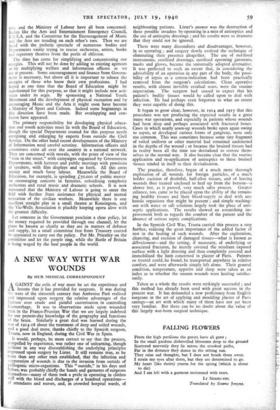A NEW WAY WITH WAR WOUNDS
By OUR MEDICAL CORRESPONDENT AGAINST the evils of war must be set the experience and lessons that it has provided for surgeons. It was during the wars of the sixteenth century that Ambroise Pare realised and impressed upon surgery the relative advantages of the ligature over crude and painful cauterisation in controlling haemorrhage. It was to observations made upon wounded men in the Franco-Prussian War that we are largely indebted for our present-day knowledge of the geography and functions of the brain. Similarly a great deal was learned during the war of 1914-18 about the treatment of deep and soiled wounds, and a good deal more, thanks chiefly to the Spanish surgeon, Trueta, now in England, during the Civil War in Spain.
It would, perhaps, be more correct to say that the process, compelled by experience, was rather one of unlearning, though Without in any way disestablishing the underlying principles impressed upon surgery by Lister. It still remains true, as he more than any other man established, that the infection and suppuration of wounds is due to the invasion from outside of pathogenic micro-organisms. This " outside," in his days and before, was probably chiefly the hands and garments of surgeons themselves—many of them took a pride in operating in clothes still with the blood and discharges of a hundred operations— of attendants and nurses, and, in crowded hospital wards, of
neighbouring patients. Lister's answer was the destruction of these possible invaders by operating in a mist of antiseptics and the use of antiseptic dressings ; and his results were so dramatic that they could not be ignored.
There were many discomforts and disadvantages, however, in so operating ; and surgery slowly evolved the technique of eliminating their presence altogether. The use of sterilised instruments, sterilised dressings, sterilised operating garments, masks and gloves, became the universally adopted alternative. It was perfected to such an extent that, in considering the advisability of an operation in any part of the body, the possi- bility of sepsis as a contra-indication had been practically removed from the surgeon's calculations. Clean operative results, with almost invisible residual scars, were the routine expectation. The surgeon had ceased to expect that his patient's bodily tissues would be called upon to deal with infection. He had perhaps even forgotten to what an extent they were capable of doing this.
It began to grow clear, however, in 1914 and 1915 that this procedure was not producing the expected results in a great many war operations, and especially in patients whose wounds had been deep and perhaps associated with fractured bones. Cases in which neatly sewn-up wounds broke open again owing to sepsis, or developed various forms of gangrene, were only too common. This was sometimes because some tiny fragment of soiled uniform or other material had remained undetected in the depths of the wound ; or because the bruised tissues had in reality been all the time too devitalised to restore them- selves in the normal way. It also became clear that the routine application and re-application of antiseptics to these bruised tissues tended in itself to their devitalisation.
The practice, therefore, began of a much more thorough exploration of all wounds for foreign particles, of a much bolder excision of doubtful, half-alive tissues, and of leaving wounds thus treated unclosed to heal up from the bottom—a slower but, as it proved, very much safer process. Greater reliance, too, came to be placed upon the ability of the remain- ing healthy tissues and their blood-supply to deal with any hostile organisms that might be present ; and simple washing- out with water or salt solutions largely took the place of anti- septic applications. The results showed an astonishing im- provement both as regards the comfort of the patient and the absence of serious septic complications.
In the Spanish Civil War, Trueta carried this process a step further, realising the great importance of the added factor of rest in the healing of such wounds. After the exploration, cleansing, and excision of damaged tissues—what is known as debridement—and the setting, if necessary, of underlying or associated fractures, he merely covered the resultant exposed surface with a light dressing and then completely covered and immobilised the limb concerned in plaster of Paris. Patients so treated could, he found, be transported anywhere in relative comfort, and were afterwards simply left alone. Their general condition, temperature, appetite and sleep were taken as an index as to whether the unseen wounds were healing satisfac- torily.
Taken as a whole the results were strikingly successful ; and this method has already been used with great success in the present war. It has demanded a new proficiency from English surgeons in the art of applying and moulding plaster of Paris casings—an art with which many of them have not yet been very familiar. But there can be no doubt about the value of this largely war-born surgical technique.


































 Previous page
Previous page